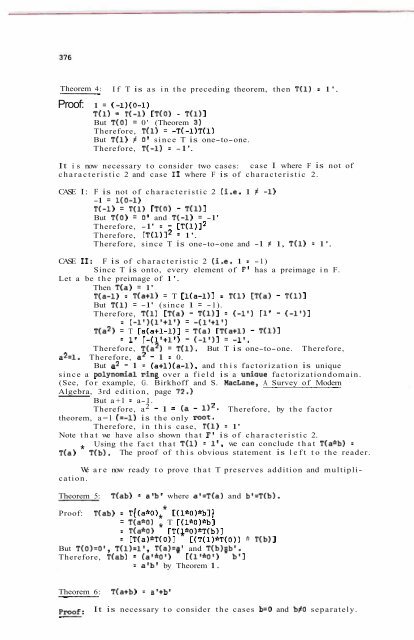Vol. 4 No 9 - Pi Mu Epsilon
Vol. 4 No 9 - Pi Mu Epsilon
Vol. 4 No 9 - Pi Mu Epsilon
Create successful ePaper yourself
Turn your PDF publications into a flip-book with our unique Google optimized e-Paper software.
Theorem 4: If T is as in the preceding theorem, then T(1) = 1'.If b=0, T(a+O) = T(a) = a' = al+O' = T(a) + T(0)If b#O,Proof: 1 = (-D(O-1)T(a+b) = T [(b*o)*((ab'l) *0)1T(1) = T(-1) [T(0) - T(DI= T(~*o) * T [(ab-l) * 01But T(0) = 0' (Theorem 3)Therefore, T(1) = -T(-l)T(l)But T(1) # 0' since T is one-to-one.Therefore, T(-1) = -1'.It is now necessary to consider two cases: case I where F is not ofcharacteristic 2 and case I1 where F is of characteristic 2.CASE I: F is not of characteristic 2 (i.e. 1 # -1)-1 = l(0-1)3 3T(-1) = T(1) rT(0) - T(l)lTan x + Tan y = 3 Tan x Tan y.But T(0) = 0' and T(-1) = -1'Therefore, -1' = - [~(l)l'Therefore, [~(l)]~ = 1'.Therefore, since T is one-to-one and -1 # 1, T(1) = 1'.CASE 11: F is of characteristic 2 (i.e. 1 = -1)Since T is onto, every element of F' has a preimage in F.Let a be the preimage of 1'.Then T(a) = 1'T(a-1) = T(a+l) = T [l(a-l)] = T(1) [T(a) - T(D1But T(1) = -1' (since 1 = -1).Therefore, T(1) [T(a) - T(l)] = (-1') rl' - (-!')I= (-1')(l1+l') = -(11+1')~ ( a = ~ T ) ra(a+l-l)l = T(a) rT(a+i) - T(1)I= it r-(lt+r) - (-1'11 = -11.Therefore, ~(a') = T(1). But T is one-to-one. Therefore,a2=1. Therefore, a2 - 1 = 0.But a2 - 1 = (a+l)(a-1). and this factorization is uniquesince a oolvnomial - - ring - over a field is a uniaue factorizationdomain.(See, for example, G. Birkhoff and S. MacLane, A Survey of ModernAlgebra, 3rd edition, page 72,)But a+l = a-1.Therefore, a 2 - 1 = (a - 1)' Therefore, by the factortheorem, a=l (=-I) is the only root.Therefore, in this case, T(1) = 1'<strong>No</strong>te that we have also shown that F' is of characteristic 2.Using the fact that T(1) = l', we can conclude that T(a*b) =T(a) * T(b). The proof of this obvious statement is left to the reader.We are now ready to prove that T preserves addition and multiplication.Theorem 5: T(ab) = a'b' where a8=T(a) and b8=T(b).Proof: T(ab) = ~{(a*0) * C(l*o)*bI}= T(a*O) T r(l*O)*b]= T(a*O) * rT(l*O)*T(b)]= CT(a)*T(O)] * [(T(l)*T(O)) * T(b)lBut T(0)=O1, T(l)=lt, T(a)=a' and T(b)=b1.Therefore, T(ab) = (at*O') * 1"(1'*Ot) * b'l= a'b' by Theorem 1.Theorem 6: T(a+b) = al+b'E: It is necessary to consider the cases b=O and b#O separately.= [T(b)*T(O)] * [~(ab-l) * T(0)lBut since T preserves multiplication ~(ab-l) = a 'b'-l.Therefore, T(a+b) = (bf*O') * [(a'b'I1) * 0'1= a' + b' by Theorem 2 is b'#0. But since b#O,and T is a one-to-one, we know that b'#O.<strong>No</strong>w that we have proven that T is a homoniurphism, it follows fromthe assumption that T is one-to-one and onto that T is an isomorphism.
















